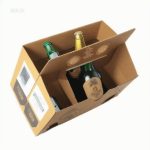In the world of food packaging, where plastic has long reigned supreme, a quiet revolution is taking place. The humble bread paper box is emerging as the hero of sustainable food storage, combining functionality with environmental responsibility in ways that are transforming how we preserve our daily bread. These unassuming containers represent more than just packaging—they embody a shift toward conscious consumption and thoughtful design that benefits both consumers and the planet.
The modern bread paper box has evolved far beyond its simple cardboard ancestors. Today’s versions feature innovative designs with reinforced corners, secure closures, and specialized paper composites that maintain optimal humidity levels. Unlike plastic bags that trap moisture and accelerate mold growth, paper boxes allow bread to breathe while protecting it from contaminants. The result? Fresher bread that lasts longer, with that perfect crusty exterior and soft interior that bread lovers cherish.
Environmental considerations make the bread paper box particularly compelling in our current climate-conscious era. Traditional plastic bread packaging contributes significantly to the global plastic waste crisis, with most bread bags ending up in landfills where they take centuries to decompose. Paper boxes, conversely, come from renewable resources and are fully recyclable and often compostable. When a bread paper box completes its primary purpose, it can be repurposed for storage, transformed into creative craft projects, or returned to the earth without leaving harmful residues.
From a practical standpoint, bread paper boxes offer surprising advantages that many consumers overlook. Their rigid structure protects delicate baked goods from being crushed during transport—a common frustration with flimsy plastic bags. The stackable design makes them space-efficient in pantries and refrigerators, while the easy-open-and-close mechanisms ensure freshness is locked in after each use. Many premium bakeries have discovered that the aesthetic appeal of paper boxes adds perceived value to their products, making customers feel they’re receiving something special rather than just another commodity item.
The manufacturing process of quality bread paper boxes has become increasingly sophisticated. Many producers now use paper sourced from sustainably managed forests and employ water-based inks for printing. Some innovative companies have developed boxes with integrated viewing windows made from compostable cellulose materials, combining the visual appeal of seeing the product with the environmental benefits of paper packaging. These advancements demonstrate how traditional materials can be reimagined through modern technology to meet contemporary needs.
Consumer response to bread paper boxes has been overwhelmingly positive, particularly among younger demographics who prioritize sustainability. Market research indicates that products packaged in paper boxes often enjoy higher perceived quality and are more likely to be chosen over plastic-wrapped alternatives, even at slightly higher price points. This consumer preference is driving more bakeries and grocery stores to make the switch, creating a virtuous cycle where demand for sustainable packaging encourages more producers to adopt environmentally friendly options.
Looking forward, the potential for innovation in bread paper boxes remains vast. Researchers are experimenting with paper composites infused with natural antimicrobial agents to further extend bread freshness. Others are developing smart packaging that can indicate freshness levels or integrate with kitchen inventory systems. As technology advances, we can expect bread paper boxes to become even more functional while maintaining their environmental advantages.
The transition to bread paper boxes represents more than just a packaging trend—it’s part of a broader movement toward thoughtful consumption and waste reduction. Each time a consumer chooses bread in a paper box over plastic packaging, they’re casting a vote for a more sustainable future. For bakeries, it’s an opportunity to align with consumer values while reducing their environmental footprint. For the planet, it means less plastic pollution and more responsible resource use. The bread paper box may seem like a small innovation, but sometimes the simplest solutions have the power to create meaningful change, one loaf at a time.




Leave a Message